Sarah Knutie, assistant professor of ecology and evolutionary biology, recently traveled to the Galapagos Islands, where she frequently conducts research. Her lab studies both fundamental and applied ideas in disease ecology and evolution, specifically how and when animals defend themselves against parasites, especially in response to environmental change. Parasites introduced to the islands are threatening many endemic bird species.
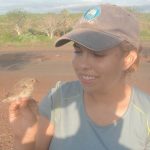
Knutie_DarwinsFinch
Sarah Knutie’s research takes her to the Galapagos Islands, where she studies the effects parasitic nest flies are having on Darwin’s Finch populations. (Sarah Knutie/UConn Photo)
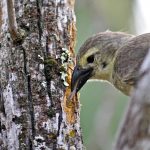
Darwin’s Finches are iconic beacons of evolution, aptly named for Charles Darwin who was inspired in part by the finches’ remarkable diversity across the islands. The bird pictured here is a woodpecker finch using a tool to collect food from within the bark of a tree. (Sarah Knutie/UConn Photo)
DarwinsFinch_WoodpeckerFinch
Darwin’s Finches are iconic beacons of evolution, aptly named for Charles Darwin who was inspired in part by the finches’ remarkable diversity across the islands. The bird pictured here is a woodpecker finch using a tool to collect food from within the bark of a tree. (Sarah Knutie/UConn Photo)
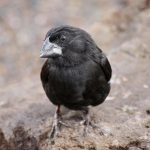
A medium ground finch, another species of Darwin’s Finch on the Galapagos Islands. As the human population grows on the islands and as tourism continues to rise, rapid urban development and further alterations to the habitat threaten the island’s ecosystems and wildlife. (Sarah Knutie/UConn Photo)
DarwinsFinch_MediumGroundFinch
A medium ground finch, another species of Darwin’s Finch on the Galapagos Islands. As the human population grows on the islands and as tourism continues to rise, rapid urban development and further alterations to the habitat threaten the island’s ecosystems and wildlife. (Sarah Knutie/UConn Photo)
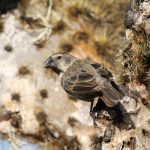
Many species of Darwin’s Finches are critically endangered, and the introduction of parasitic nest flies has further threatened populations. Knutie’s research is exploring whether Darwin’s Finches are evolving to defend themselves against this parasite, and whether urbanization has affected interactions between the finches and the parasite. (Sarah Knutie/UConn Photo)
DarwinsFinch_MediumGroundFinch2
Many species of Darwin’s Finches are critically endangered, and the introduction of parasitic nest flies has further threatened populations. Knutie’s research is exploring whether Darwin’s Finches are evolving to defend themselves against this parasite, and whether urbanization has affected interactions between the finches and the parasite. (Sarah Knutie/UConn Photo)
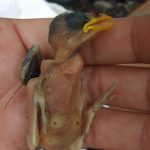
The nest fly parasite, Philornis downsi, has been implicated in the decline of critically endangered species of endemic Darwin’s Finches. The non-parasitic adult flies lay eggs in the nests, where the parasitic larvae will hatch and feed upon birds within the nest. (Sarah Knutie/UConn Photo)
DarwinsFinch_Nestling_Parasitized
The nest fly parasite, Philornis downsi, has been implicated in the decline of critically endangered species of endemic Darwin’s Finches. The non-parasitic adult flies lay eggs in the nests, where the parasitic larvae will hatch and feed upon birds within the nest. (Sarah Knutie/UConn Photo)
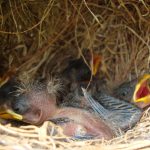
Research has found that parasitized young birds generally have reduced rates of survival. However, just as the Darwin’s Finch’s physical characteristics vary across species, Knutie’s research has shown that immune defenses against parasites also vary within Darwin’s Finches. She has also developed a technique whereby the birds ‘self-fumigate’ their nests, by incorporating insecticide-treated thread into the nest structure. (Sarah Knutie/UConn Photo)
DarwinsFinch_Nestlings
Research has found that parasitized young birds generally have reduced rates of survival. However, just as the Darwin’s Finch’s physical characteristics vary across species, Knutie’s research has shown that immune defenses against parasites also vary within Darwin’s Finches. She has also developed a technique whereby the birds ‘self-fumigate’ their nests, by incorporating insecticide-treated thread into the nest structure. (Sarah Knutie/UConn Photo)



